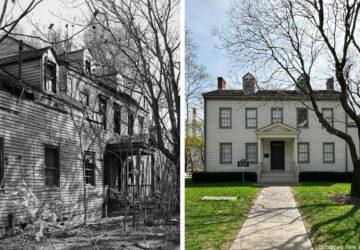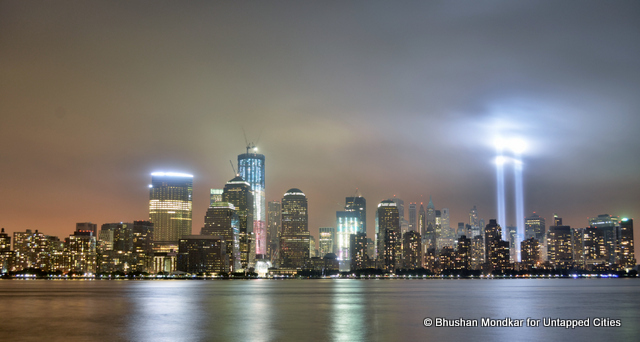
Today, we commemorate the tragedy of 9/11. This year marked the completion of the National September 11 Memorial Museum, but there are many powerful World Trade Center artifacts and memorials on display all around New York City. The city has far from forgotten the tragedy; New York has integrated the scar left on September 11th, 2001 into both the city’s structure and its spirit. In this piece, we trace how the World Trade Center has evolved from when the site was still under the Hudson River up to construction of 1 World Trade Center, the tallest building in NYC.
1776: Before Battery Park
The 1776 map shows that the western portion of the first World Trade Center would originally have been under the Hudson River shoreline. It was here, close to the intersection of Greenwich and Dey Streets, that Dutch explorer, Adraien Block’s ship, Tjger, burned to its waterline in November 1613. Leaving Block and his crew stranded, they were forced to overwinter on Manhattan Island. The remains of the ship were buried under the landfill when the shore started being extended in 1797. It was later discovered in 1916 during excavation work. You can trace the evolution of the shoreline further in here, but for now we’ll jump to more recent history.
1966: Loss of Radio Row
From 1921 to 1966, Radio Row occupied the area which is now the World Trade Center, roughly 13 blocks of warmly cluttered shops for “techies” of the radio era. The changing shoreline was last altered in the 1960s at the start of Radio Row demolitions. Radio Row was targeted for redevelopment by David Rockefeller who decided, in 1958, that this spot was the ideal downtown location for the World Trade Center, particularly given the needs for the Port Authority to connect New Jersey and New York. The community was furious, but Rockefeller’s success at the new Rockefeller Center and his governor brother gave the developers the leverage they needed to obtain this already “cluttered” real estate via eminent domain.
August 1966: Groundbreaking
With the site cleared and development ready to take off, groundbreaking began for the new World Trade Center in August 1966.
1968-1972: Completion of Twin Towers
In 1968, construction of the towers by Minoru Yamasaki began and in just two years, the first tenant moved into the North Tower. In early 1972, the first major tenants moved into the South Tower. These included Morgan Stanley, New York Stock Exchange, and Dow Jones.
1971: Tallest Building in the World
The twin towers premiered as the tallest buildings in the world–1,368 and 1,362 feet with 110 stories each. The entire project had been criticized from the get go: Jane Jacobs wanted the waterfront to be left clear and Lewis Mumford thought the towers looked like huge filing cabinets. The towers had an Observation Deck and a hotel, and the famous Windows on the World Restaurant on the 106th and 107th floors. In 1974, tightrope walker Phillipe Petit spent 45 minutes in the air making eight crossings and dancing and jumping on the wire, and nobody thought to film it. Nonetheless, in inspired the Oscar-winning documentary Man on Wire.
1982: Battery Park as a Beach and a Wheat Field?
Urban geography is always changing. In 1982, the World Trade Center complex was still incomplete, and so was Battery Park City, a planned neighborhood on landfill that took decades to complete due to the city’s financial situation. In the meantime, it was used in various ways from a beach to art installation.
In 1982, Agnes Denes created a 2-acre wheat field on the landfill two blocks from Wall Street and the World Trade Center. This field represented food, energy, commerce, world trade, and economics calling to attention mismanagement, waste, world hunger and ecological concerns. This kind of activism condemned the entire world that is Downtown Manhattan, including the towers whose inner-walls dealt with “misguided priorities” and “entitled traders.”
1993: World Trade Center is Bombed
On February 26, 1993 a truck bomb explodes on the second level of the North Tower parking basement, creating a crater 150 feet in diameter and 5 floors deep. Six people were killed and more than a thousand injured. Despite this, NYC’s Office of Emergency Management remained at the World Trade Center until 9/11 when it was also destroyed in the attacks.
September 11th, 2001: Attack on the World Trade Center
On September 11th 2001, the towers were destroyed. For a haunting timeline of the day’s events, see The New York State Museum’s Timeline at Ground Zero. Within a few months, plans for a memorial were already being drawn up during cleanup. This image was taken on September 23rd, 2001 by the United States National Oceanic and Atmospheric Administration from an altitude of 3,300 feet.
2002: Competition for a site plan
Initially, there wasn’t a competition at all for the redesign of the World Trade Center. Six proposals by Beyer Blinder Belle were released to the public and were widely denounced. On November 30, 2001, Governor George Pataki and New York City Mayor Rudoph Guiliani established the Lower Manhattan Development Corporation (LMDC) to oversee the rebuilding of the World Trade Center site and downtown Manhattan. The LMDC instituted conduits of accountability, ranging from advisory councils, to public hearings, and regularly meetings with civic organizations and public officials. Nonetheless, the LMDC still absolved itself of taking full accountability of the public opinion. A competition began in the spring of 2003, which was narrowed down to six architectural teams. A design by Daniel Liebeskind is ultimately chosen but apart from building massing and layout, little remains architecturally of the winning plan after a decade of politics and changes.
2006: 7 WTC Opens, First New Building on WTC Site
2006: Freedom Tower/1 WTC
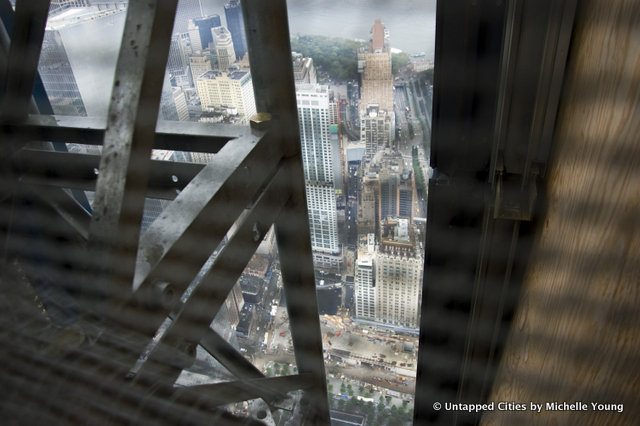
Construction began in 2006 for the Freedom Tower (now named 1 WTC). Toward the end, we got to take a behind-the-scenes tour of the construction site.
2011: 9/11 Memorial opens

In September 2011, the 9/11 Memorial was openedesigned by Michael Arad opens featuring two reflecting pools marking the former footprints of the World Trade Center.
November 2013: 4 WTC Opens

May 2014: 9/11 Memorial & Museum Opens
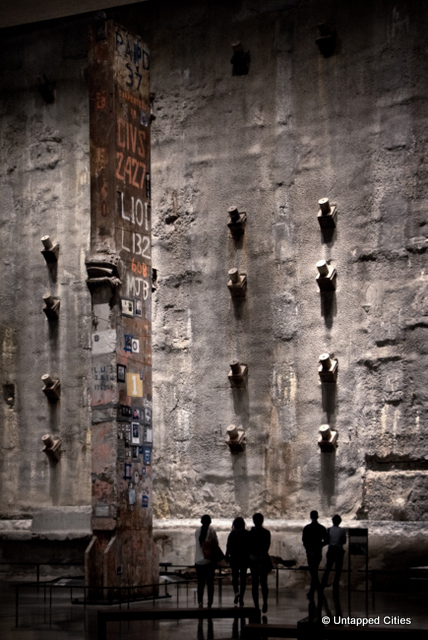
Earlier this year, the National September 11 Memorial & Museum opened.
2015: World Trade Center Transit Hub (PATH) to be Completed
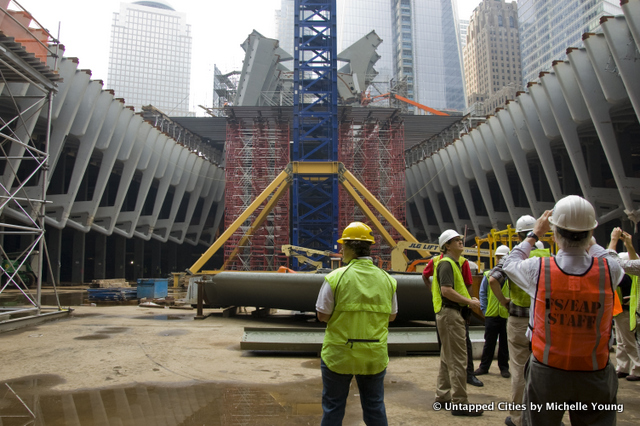
The remaining transit hub by architect Santiago Calatrava is long overdue, past budget and highly controversial. We got to check out the construction which is coming together, slowly but surely.
Still going on…
Four years since the suggestion to replace the Muslim sites of worship at 45-51 Park with a large-scale Islamic community center dubbed Park51, the issue is still being debated. Its relative proximity to Ground Zero has caused 9/11 families, politicians, anti-Islamists, other religious organizations, and even some Muslims to speak out in disapproval. This year, a new proposal suggests condos and a museum of Islam, which would maintain the existing mosque.
See our previous 9/11 coverage including:
10 Powerful World Trade Center Artifacts and Memorials On Display in NYC
Inside the 9/11 Memorial and Museum
Mr. Brainwash Is Painting A Tribute to 9/11 Victims Near the World Trade Center
9/11 Tiles for America Now On Display at Jefferson Market Library in NYC’s Greenwich Village
39 Years Ago, A Tightrope Walk Between the Twin Towers Becomes “Artistic Crime of the Century”
Inside the 9/11 Memorial: An Essay with No Words
Behind the Scenes at the Construction of 1 WTC, Freedom Tower [PHOTOS]
